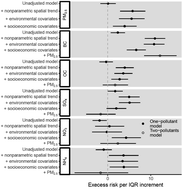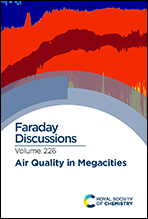A component-specific exposure–mortality model for ambient PM2.5 in China: findings from nationwide epidemiology based on outputs from a chemical transport model†
Abstract
Long-term exposure to ambient fine particles (PM2.5) has been evidenced to be a leading contributor to premature mortality in China and many other countries. Previous studies assess the health risk using an exposure–response function, such as an exposure–mortality model (EMM) based on total concentration of PM2.5. However, the risk assessment method can be problematic as it ignores the unequal toxicity between the different chemical components of PM2.5. To derive a components-specific EMM (CS-EMM), we conducted a whole-population-based epidemiology study in China, using the Chinese Population Census data in 2000 and 2010. Concentrations of ambient PM2.5 and its components were assessed by satellite-based concentrations of PM2.5 and composition fractions simulated by a chemical transport model. We used a difference-in-difference approach to associate county-level changes of census-based total mortality with changes of PM2.5 and its components between 2010 and 2000. The chemical components of PM2.5 simulated by the model included sulfate (SO42−), nitrate (NO3−), ammonium (NH4+), organic carbon (OC), and black carbon (BC). We further compared CS-EMM with EMM based on a single pollutant of PM2.5 (PM2.5-EMM) or black carbon (BC-EMM), by evaluating their performance in a risk assessment. Using census-based total mortality and cross validation we evaluated the performance of the mortality prediction of an EMM, and found that the CS-EMM outperformed PM2.5-EMM or BC-EMM. For instance, CS-EMM, PM2.5-EMM, and BC-EMM all overestimated the average number of county-level deaths by 117, 142, and 149, respectively; hence CS-EMM overestimated by the lowest amount. Moreover, CS-EMM had the advantage of interpreting the toxicity of PM2.5 mixture in its entirety. From 2000 to 2010, CS-EMM attributed a 205 496 increase in PM2.5-associated mortality across China to the joint contribution of the growth of total concentration and the reduction of PM2.5 toxicity. Among the components, BC contributed 6.4% of PM2.5 concentration growth, but corresponded to a 46.7% increment in PM2.5-associated deaths. This study developed a framework to establish and validate an exposure–response function based on PM2.5 components, and illustrated its advantages in terms of risk prediction and result interpretation in China. Our approach can be utilized to evaluate how chemical composition modified the health impact of PM2.5, and should help policy-makers target the toxic sources of air pollution.

- This article is part of the themed collection: Air quality in megacities


 Please wait while we load your content...
Please wait while we load your content...